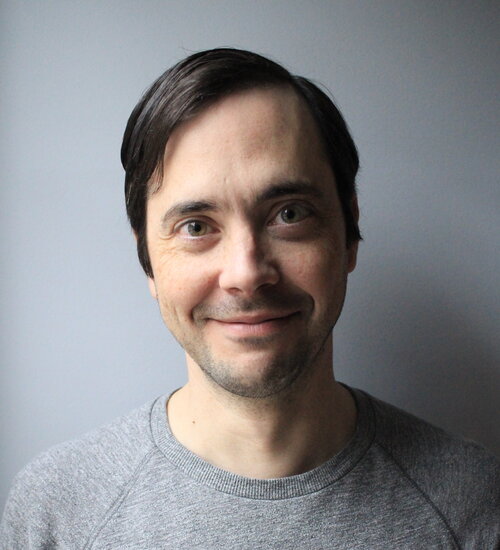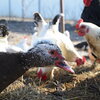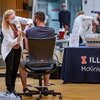
Contact Information
MC-110
601 South Goodwin Avenue
Urbana, IL 61801
Research Interests
Research Topics
Host-Pathogen Interactions, Molecular Evolution, Molecular Immunology, Regulation of Gene Expression, Virology
Disease Research Interests
Infectious Diseases
Research Description
Understanding viral replication, pathogenesis, and evolution
Influenza virus remains a major global health concern, despite the decades-long existence of a licensed vaccine. This ongoing threat is a direct function of the virus’ remarkable adaptability, which enables it to transmit within and between widely divergent host species while deftly evading herd immunity. Unfortunately, we still know very little about the specific mechanisms that govern influenza virus transmission, pathogenesis, and evolution.
My laboratory is primarily focused on understanding how heterogeneity and collective interactions within virus populations influence broader patterns of viral evolution and infection outcomes. Influenza virus populations are enormously heterogeneous, and most viral particles carry a functionally incomplete set of gene segments and thus cannot replicate independently. Rather than serving as dead-end products, widespread co-infection in vivo allows these incomplete particles to replicate and exchange gene segments through complementation. Collective interactions between heterogeneous particles can have profound effects on the behavior of the population as a whole, and the outcome of infection. We and our collaborators are currently employing a wide range of approaches spanning molecular virology, cell biology, evolutionary biology, single cell microfluidics, bioinformatics, and mathematical modeling to better understand this crucial, under-explored area of virus biology.
We are also interested in understanding the genetics of influenza virus immune escape and transmission, with the overall goal of improving strategies for universal vaccination. The specific factors that govern the continual antigenic evolution of influenza virus within the human population remain poorly understood. We have developed improved methods for ultra-deep viral population sequencing that allow us to dissect the process of antigenic evolution within and transmit between hosts like never before.
Specific areas of study within the lab include:
- Defining how patterns of viral heterogeneity and collective interactions within viral populations influence their evolutionary and pathogenic potential.
- Understanding how cellular heterogeneity and stochastic patterns of antiviral immune induction shape the host response to infection.
- Defining the epistatic interactions between viral gene segments and determining how they influence viral evolution.
- Using single-particle/single-cell analysis to examine how the interplay between viral and host heterogeneity shapes infection outcome.
- Employing ultra-deep population sequencing methods to understand how influenza populations maintain fitness while evading host immunity.
Education
B.A. (Biology), Washington University, 2003
Ph.D (Microbiology & Immunology), University of North Carolina, 2010
Postdoctoral (Viral Immunology), Laboratory of Viral Diseases, NIAID, 2010-2015
Additional Campus Affiliations
External Links
Highlighted Publications
Representative Publications
Rivera Cardona J and Brooke CB. 2023. How influenza shuts down host transcription. Nature Microbiology. DOI: 10.1038/s41564-023-01416-9.
Farjo M and Brooke CB. 2023. When influenza viruses don’t play well with others. Nature. DOI: 10.1038/d41586-023-00983-5.
Liu T, Wang Y, Tan TJC, Wu NC, and Brooke CB. 2022. The evolutionary potential of the influenza A virus hemagglutinin is highly constrained by epistatic interactions with neuraminidase. Cell Host & Microbe. DOI: 10.1016/j.chom.2022.09.003.
Ke R, Martinez PP, Smith RL, Gibson LL, Mirza A, Conte M, Gallagher N, Luo CH, Jarrett J, Conte A, Liu T, Farjo M, Walden KKO, Rendon G, Fields CJ, Wang L, Fredrickson R, Edmonson DC, Baughman ME, Chiu KK, Choi H, Scardina KR, Bradley S, Gloss SL, Reinhart C, Yedetore J, Quicksall J, Owens AN, Broach J, Barton B, Lazar P, Heetderks WJ, Robinson ML, Mostafa HH, Manabe YC, Pekosz A, McManus DD, and Brooke CB. 2022. Daily sampling of early SARS-CoV-2 infection reveals substantial heterogeneity in infectiousness. Nature Microbiology. DOI: 10.1038/s41564-022-01105-z.
Diefenbacher M, Tan TJC, Bauer DLV, Stadtmueller B, Wu NC, and Brooke CB. 2022. Interactions between influenza A virus nucleoprotein and gene segment UTRs facilitate selective modulation of viral gene expression. J. Virology. DOI: 10.1128/jvi.00205-22.
Ke R*, Martinez PP*, Smith RL, Gibson LL, Achenbach CJ, McFall S, Qi C, Jacob J, Dembele E, Bundy C, Simons LM, Ozer EA, Hultquist JF, Lorenzo-Redondo R, Opdycke AK, Hawkins C, Murphy RL, Mirza A, Conte M, Gallagher N, Luo CH, Jarrett J, Conte A, Farjo M, Rendon G, Fields CJ, Wang L, Fredrickson R, Baughman ME, Chiu KK, Choi H, Scardina KR, Owens AN, Broach J, Barton B, Lazar P, Robinson ML, Mostafa HH, Manabe YC, Pekosz A, McManus DD, and Brooke CB. 2022. Longitudinal analysis of SARS-CoV-2 vaccine breakthrough infections reveal limited infectious virus shedding and restricted tissue distribution. Open Forum Infectious Diseases. DOI: 10.1093/ofid/ofac192. * Authors contributed equally.
Alnaji FG, Reiser WK, Rivera-Cardona J, te Velthuis AJW, and Brooke CB. 2021. Influenza A virus defective viral genomes are inefficiently packaged into virions relative to wild-type genomic RNAs. mBio. DOI: 10.1128/mBio.02959-21.
Smith RL, Gibson LL, Martinez PP, Ke R, Mirza A, Conte M, Gallagher N, Conte A, Wang L, Fredrickson R, Edmonson DC, Baughman ME, Chiu KK, Choi H, Jensen TW, Scardina KR, Bradley S, Gloss SL, Reinhart C, Yedetore J, Owens AN, Broach J, Barton B, Lazar P, Henness D, Young T, Dunnett A, Robinson ML, Mostafa HH, Pekosz A, Manabe YC, Heetderks WJ, McManus DD, and Brooke CB. 2021. Longitudinal assessment of diagnostic test performance over the course of acute SARS-CoV-2 infection. J. Infect. Dis. DOI: 10.1093/infdis/jiab337.
Martin BE, Harris JD, Sun J, Koelle K, and Brooke CB. 2020. Cellular co-infection can modulate the efficiency of influenza A virus production and shape the interferon response. PLOS Pathogens. DOI: 10.1371/journal.ppat.1008974
Sun J, Vera JC, Drnevich J, Lin YT, Ke R, and Brooke CB. 2020. Single cell heterogeneity in influenza A virus gene expression shapes the innate antiviral response to infection. PLOS Pathogens. DOI: 10.1371/journal.ppat.1008671.
Alnaji FG and Brooke CB. 2020. Influenza virus DI particles: defective interfering or delightfully interesting? PLOS Pathogens. DOI: 10.1371/journal.ppat.1008436.
Martin BE and Brooke CB. 2019. Flu shows the power of diversity. Cell. DOI: 10.1016/j.cell.2018.12.017.
Alnaji FG, Holmes JR, Rendon G, Vera JC, Fields CJ, Martin BE, and Brooke CB. 2019. Sequencing framework for the sensitive detection and precise mapping of defective interfering particle-associated deletions across influenza A and B viruses. J. Virol. DOI: 10.1128/JVI.00354-19.
Sun J and Brooke CB. 2018. Influenza A virus superinfection potential is regulated by viral genomic heterogeneity. mBio. DOI: 10.1128/mBio.01761-18.
Diefenbacher M, Sun J, and Brooke CB. 2018. The parts are greater than the whole: the role of semi-infectious particles in influenza A virus biology. Curr. Opin. in Virol. DOI: 0.1016/j.coviro.2018.07.002.
Kosik I, Ince WL, Gentles L, Oler AJ, Kosikova M, Angel M, Magadan J, Xie H, Brooke CB* and Yewdell JW*. 2018. Influenza A virus hemagglutinin glycosylation compensates for antibody escape fitness costs. PLOS Pathogens. DOI: 10.1371/journal.ppat.1006796. *Authors contributed equally
Brooke CB. 2017. Population diversity and collective interactions during influenza virus infection. J. Virol. PMID: 28855247.
Brooke CB*, Ince WL*, Bennink JR, and Yewdell JW. 2014. Influenza A virus nucleoprotein selectively decreases neuraminidase gene segment packaging while enhancing fitness and transmissibility. PNAS. 111(47): 16854-16859. *Authors contributed equally
Brooke CB, Ince WL, Wrammert J, Ahmed R, Wilson PC, Bennink JR, and Yewdell JW. 2012. Most influenza A virions fail to express at least one essential viral protein. J. Virol. 87(6): 3155-62.
Recent Publications
Hu, Z., Ai, H., Wang, Z., Huang, S., Sun, H., Xuan, X., Chen, M., Wang, J., Yan, W., Sun, J., Pu, J., Brooke, C. B., Chang, K. C., Sun, Y., & Liu, J. (2025). Impact of inactivated vaccine on transmission and evolution of H9N2 avian influenza virus in chickens. npj Vaccines, 10(1), Article 67. https://doi.org/10.1038/s41541-025-01115-y
Lennon, J. T., Rappuoli, R., Bloom, D. E., Brooke, C., Burckhardt, R. M., Dangour, A. D., Egamberdieva, D., Gronvall, G. K., Lawley, T. D., Morhard, R., Mukhopadhyay, A., Peixoto, R. S., Silver, P. A., Sperandio, V., Stein, L. Y., & Nguyen, N. K. (2025). Microbial solutions for climate change require global partnership. mBio, 16(5). https://doi.org/10.1128/mbio.00778-25
Teo, Q. W., Wang, Y., Lv, H., Oade, M. S., Mao, K. J., Tan, T. J. C., Huan, Y. W., Rivera-Cardona, J., Shao, E. K., Choi, D., Wang, C., Dargani, Z. T., Brooke, C. B., te Velthuis, A. J. W., & Wu, N. C. (2025). Probing the functional constraints of influenza A virus NEP by deep mutational scanning. Cell Reports, 44(1), Article 115196. https://doi.org/10.1016/j.celrep.2024.115196
Farjo, M., Koelle, K., Martin, M. A., Gibson, L. L., Walden, K. K. O., Rendon, G., Fields, C. J., Alnaji, F. G., Gallagher, N., Luo, C. H., Mostafa, H. H., Manabe, Y. C., Pekosz, A., Smith, R. L., McManus, D. D., & Brooke, C. B. (2024). Within-host evolutionary dynamics and tissue compartmentalization during acute SARS-CoV-2 infection. Journal of virology, 98(1). https://doi.org/10.1128/jvi.01618-23
Liu, T., Reiser, W. K., Tan, T. J. C., Lv, H., Rivera-Cardona, J., Heimburger, K., Wu, N. C., & Brooke, C. B. (2024). Natural variation in neuraminidase activity influences the evolutionary potential of the seasonal H1N1 lineage hemagglutinin. Virus Evolution, 10(1), Article veae046. https://doi.org/10.1093/ve/veae046




